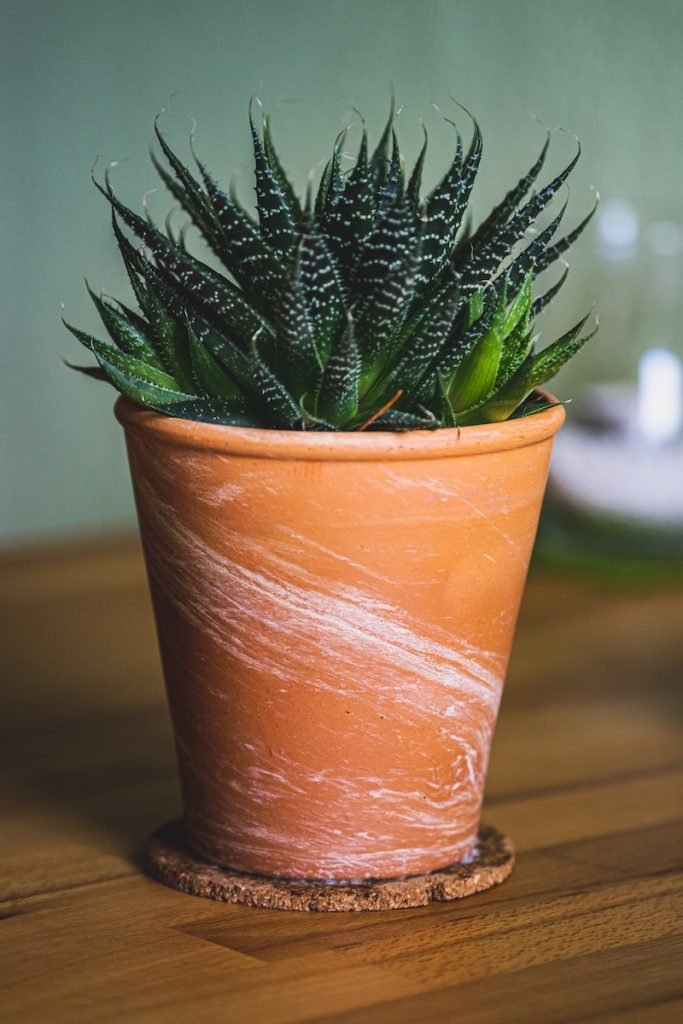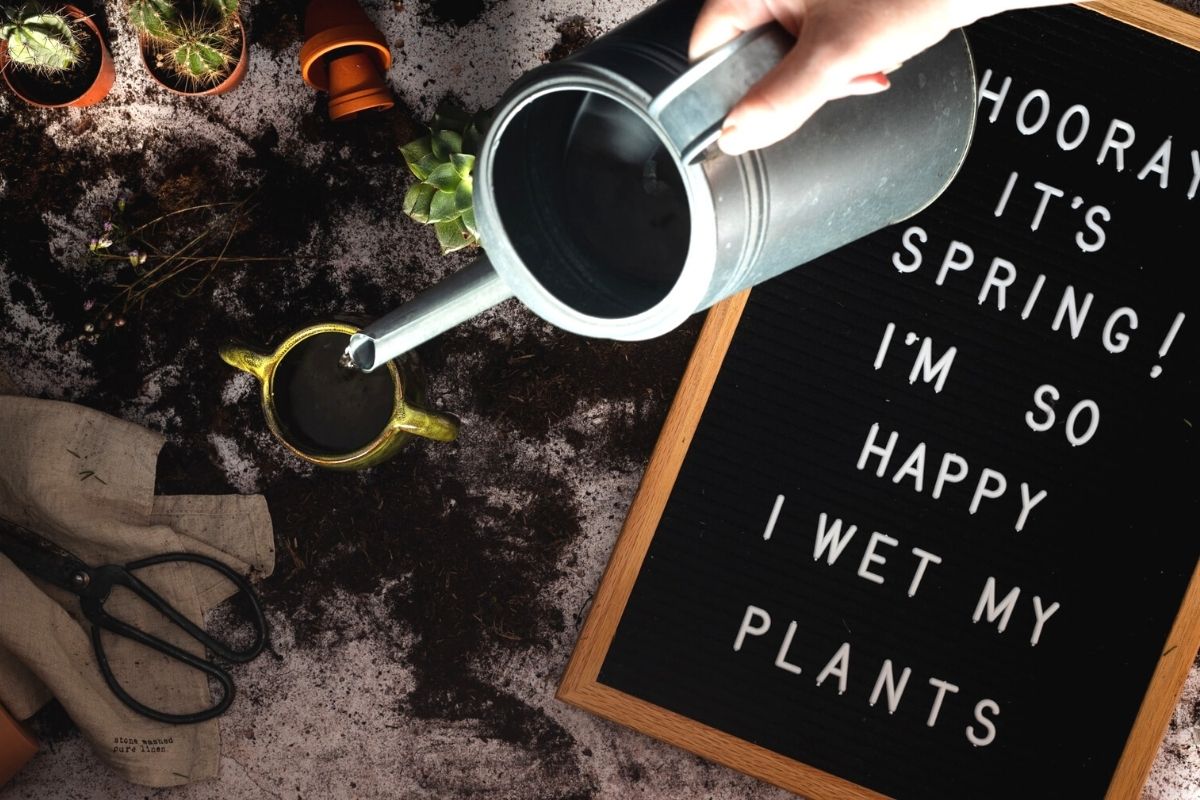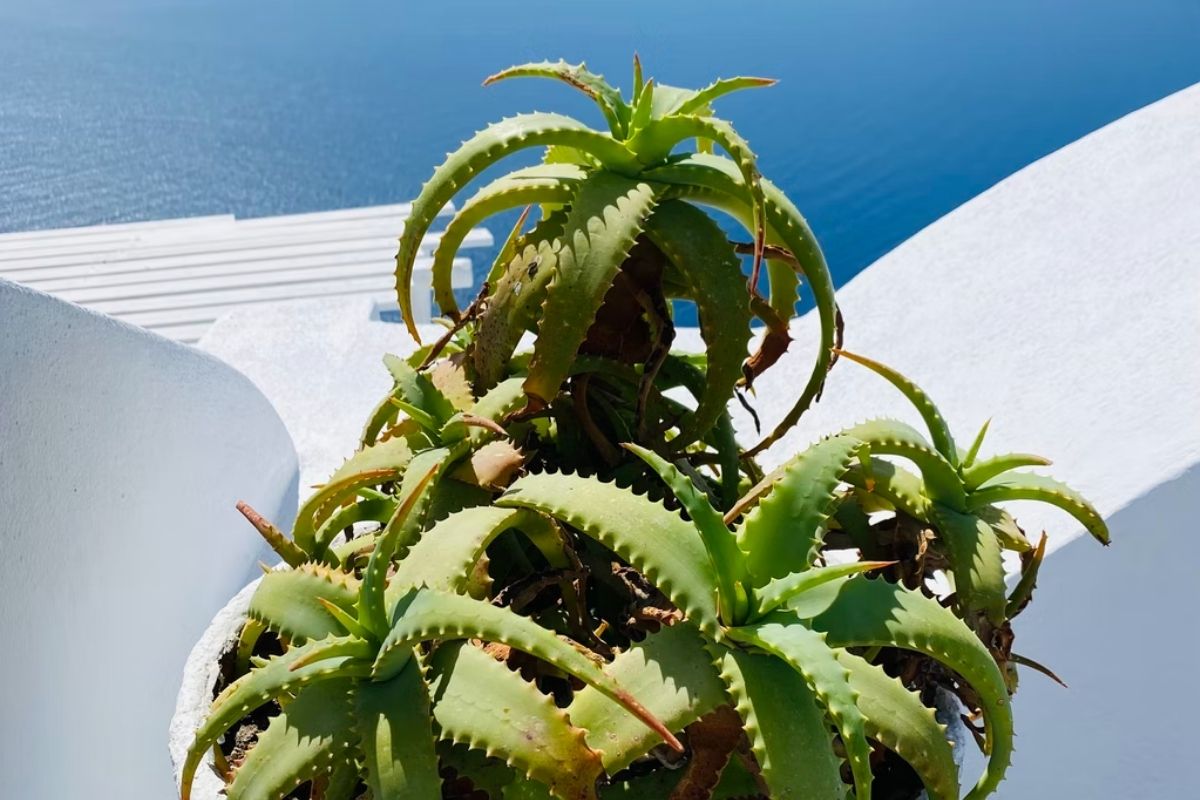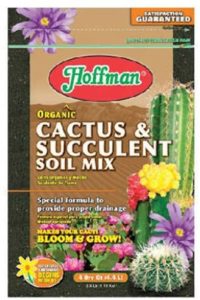We spend a lot of time subtly encouraging our readers NOT TO OVERWATER YOUR PLANTS 🚫 (ok, maybe not so subtly) – but underwatering is not the answer either as you surely know. You have an underwatered aloe plant in your care and are wondering what in the world can be done to save it.
Aloe vera is one of those plants that’s a bit more likely to be underwatered than the average pothos due to its reputation for doing so well in dry soil. So well, in fact, that you just… forget to water it altogether 😳
In fact, an aloe plant should be watered at regular intervals; once every week or two to keep it healthy and happy! Like other medicinal plants, aloe won’t cure so much as boredom if you don’t attend to it somewhat regularly.
Buuut, you’re not there yet; first you have a rescue mission to accomplish. We’ve put together all of our rescue tips in this article for how to save an underwatered aloe plant quickly and effectively, and what to do when you see the most common warning signs of a parched aloe plant.

What does an underwatered aloe plant look like?
Plants absorb nutrients from the soil through water, which transports both water and essential nutrients throughout the plant’s root and stem system to plant cells. Plants like aloe that hold lots of moisture in their tissues (succulents and cacti in particular) can go longer than regular plants without water.
In nature, this cycle is totally normal! Aloe plants don’t get much rain in the wild, arid regions in which they originate, and they often wait long periods between precipitation events (in weather lingo, this means water falling from the sky, AKA rain; a show-stopper in the most literal sense).
When aloe is kept indoors, it thrives with a regular watering schedule that keeps nutrients and moisture hydrating its fleshy leaves. Underwatering your aloe will leave the plant dehydrated and malnourished!
When plant-whispering, you need to listen to its leaves. An underwatered aloe plant will show you it’s dehydrated when its sword-like leaves droop, turn yellow, or dry out at the tips (if your aloe plant is droopy but not de-hydrated, that’s another story).
When left for too long, the leaves will start to shrivel up like raisins and curl inwards (not good). If you can recognize the most common signs of an underwatered aloe plant by keeping an eye on its leaves, you should be able to save your plant before it’s too late:
- Brown tips. The tips of the leaves are the last part of the plant to receive water and nutrients, so they will be the first place to start to show signs of dehydration. When underwatered, the tips of your aloe’s leaves will dry out, shrivel, and turn brown. You may also see brown edges along its leaves.
- Wrinkles. Moisture retention makes the leaves plump, which should feel full and dense when squeezed gently, and not have any give. Deflated, wrinkly, or droopy aloe leaves mean the plant is having to tap its own moisture to survive a period of drought. This is what aloe is adapted for, but too little water will begin to put some stress on the plant.
- Yellowing. Your aloe’s yellow leaves signal distress. While yellowing leaves can also be a sign of overwatered aloe vera plants, very dry potting soil will confirm that your plant isn’t getting enough moisture. An underwatered aloe plant won’t be able to absorb nutrients from the soil, which it requires to perform photosynthesis. Unable to produce chlorophyll, the aloe vera will lose its characteristic dark green color and begin to turn yellow. When the plant is especially dehydrated, it will turn brown and may develop even darker spots along the edges of the leaves.
- Drooping. As your aloe’s leaves lose moisture and nutrients, they will lose their proud crown shape and start to droop. Without water retained at the cellular level of the plant, it won’t be able to hold itself up anymore and will start to bend under its own weight.
- Curling. When an aloe plant begins to curl its leaves inwards, it is severely dehydrated and has lost a lot of moisture. The leaves begin to constrict to make the use of their remaining reserve more efficient. With less surface area to cover, the aloe leaves will continue to dry unless they receive moisture and nutrients to straighten out and start producing energy again.
The good news? Once the signs of an underwatered aloe plant begin to appear, then you’ll be able to remedy your thirsty little aloe plant pretty easily.
How to save an aloe vera plant after underwatering
If you notice your aloe plant is showing signs of dehydration from underwatering, you should inspect the plant to evaluate its condition, then water it and move it to a spot with moderate light.
Depending on the extent of damage from dehydration, an underwatered aloe vera plant will be able to absorb the nutrients it needs to perform photosynthesis, store moisture, and regain its firm structure relatively soon after a spell of underwatering. These plants have spent thousands of years adapting to drought conditions, after all!
Step 1: water your aloe plant
You have two options to water your underwatered aloe plant: Either soak its soil and set it aside to absorb the water and drain away excess, or use a spray bottle to deliver less water more frequently to nurse it to health.
Using a spray bottle will minimize your chances of overwatering the aloe plant during your regular watering schedule. If you use a spray bottle, be sure the plant’s leaves don’t stay consistently moist.
Step 2: remove damaged leaves
Most of the time, yellow leaves will regain their green color after a few days once given water, although their bounce-back depends on the size of the plant and the extent of its dehydration.
However, some leaves that have been damaged by dehydration may not be able to recover from the stress to the plant cells and tissue, whether from the lack of moisture or from excessive bending. Remove damaged or dried aloe vera leaves to redirect energy to supporting healthy growth of the surviving portions of the aloe plant.
Step 3: set the plant in indirect sunlight
Aloe plants recovering from dehydration should be put in indirect light or (temporarily) a location with moderate light. This will help the plant retain moisture as it recovers. Direct sunlight can speed up a plant’s dehydration, and may result in the plant not getting enough water despite being on a regular schedule.
Warm temperatures and direct sunlight evaporate excess water out from the soil, in addition to encouraging transpiration from the plant itself.
Step 4: support weak leaves
Project perk-up: When aloe leaves have weakened to the point that they droop and bend, they will definitely benefit from some support while the plant heals.
You can set up a small string fence in the pot around the aloe to hold the leaves vertically while it regains its strength and remove some of the stress on the plant.
What you will need:
- String
- 4-5 bamboo or wood sticks about 10 inches long
- Scissors
Gently bring the droopy leaves up to the center, and tie them together temporarily while you build the support around it. Stick 4-5 bamboo poles in the pot around the plant, and tie the string between each pole around the aloe, creating a small fence-like structure. Make 3-4 levels of string fencing around the aloe, which will hold the plant upright as it recovers.

Tips for reviving a dehydrated aloe vera plant
Hurray, you saved your plant! Now… How did we get here? It’s time to reflect on the maintenance schedule you kept for your plant so you don’t make the same mistakes again – or at least, do better this time ☺️ Here are some general tips to keep in mind when re-adjusting your watering schedule:
- Aloe vera likes a lot of bright, indirect light rather than direct sun. Even though it’s a desert plant, high temperatures and direct sunlight can burn the leaves and contribute to dehydration and stress. Heat and direct sunlight also dry out the soil more quickly. Generally, aloe plants only need to be watered once or twice a week. A moisture meter can help you be sure you’re not overwatering.
- A soil moisture meter will help you be sure your aloe plant isn’t getting more water than it needs. If you don’t want to feel the soil with your fingers, or your aloe is in a deep pot, a moisture meter will show you the water content of the soil before you add more. Aloe likes the soil to dry out completely before its next watering, so verifying the moisture content is an important way of avoiding soil saturation.
- Aloe shouldn’t be watered more than once a week. A spray bottle is a great way to control how much water your aloe is getting, and monitoring the plant for its responses to the amount of water you’re giving it will help you be sure the plant is on the right watering schedule. Be sure the leaves dry completely and don’t stay moist, however, as the plant doesn’t like high humidity.
- Use well-draining soil in pots with drainage holes. The best soil for aloe vera is a dry potting soil mix specifically made for cacti and succulents. These mixes usually are at most 50% potting soil and the rest coarse material like orchid or pine bark, coco coir, and sphagnum moss. These solids keep the soil porous to maintain the oxygen content, fill up space where water won’t sit, and drain the water down with their non-absorbent surfaces.
Now that you know how to revive an underwatered aloe plant, let’s look at how to water aloe vera plants properly.
How often to water an aloe plant
We all know that aloe vera plants are pretty low-maintenance, but they still need their H2O fix every now and then. The frequency of watering an aloe plant will depend on a few factors such as the size of the pot, the amount of light and heat the plant receives, and the type of soil used.
Basically: what’s the aloe plant’s environment look like?
First, I’m going to explain their natural environments and then we can talk about how often to water aloe plants.
Aloes are like the desert queens of the plant world – they can withstand some serious drought. In the wild, these plants come from arid regions where rainfall is scarce, and they’ve learned to make the most of what little water they get.
Aloe plants store water in their tissues, like little water balloons, and use it as needed. This is what makes them so drought tolerant. So, while it’s true that aloes can go longer without water than your average plant, they still need a little water to thrive.
They’ve got a root system that’s perfectly adapted to their dry and dusty homes. The roots of an aloe plant grow close to the surface, like they’re on the lookout for any drops of water that might be passing by.
And when they do find some moisture, these roots go to work, absorbing every last drop like they’re at an all-you-can-drink water fountain. To make sure they don’t miss a drop, these roots have tiny little hairs that are like water-sensing antennas. They help the roots absorb even more water, so the plant can stay healthy and hydrated.
So providing well draining potting mix, such as cactus soil, is the best way to support your aloe vera plant’s natural processes. Then, it’s a mattering of watering it properly.
If you’re not sure when to water your aloe, just give it a little poke – if the potting soil feels dry to the touch, it’s thirsty for more. But don’t overdo it!
A more accurate way to determine when to water an aloe plant is to check the moisture level of the soil using a moisture meter or by sticking a finger into the soil. You should feel dry soil at least a few inches down before watering your aloe vera plant again.
That’s a good way to prevent an overwatered aloe plant. So how do you prevent an underwatered aloe vera plant?
A good rule of thumb is to water your aloe plant thoroughly until water drains out of the bottom of the pot and then wait for the soil to dry out completely before watering again. Think of it like giving your plant a spa treatment – a little soak and then a little dry time to breathe.
This soak-and-dry method ensures that the roots receive enough water and allows the soil to aerate, which prevents root rot. Overwatering can be just as bad as underwatering, so don’t drown your plant with too much love (or water).
More about watering plants
- How Often To Water Dracaena (Including Snake Plants)
- How to Use Leca for Plants: Step-by-Step Guide with Pictures
- How To Save An Overwatered Snake Plant
- How Often To Water Pothos Plants (And When To Cut Back)
- How Often To Water Monstera Plants
- 11 Plants That Don’t Need Drainage And How To Care For Them
- Save Your Overwatered Monstera In 4 Steps (And How Not To Do It Again)





